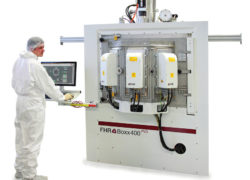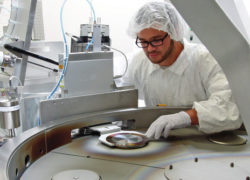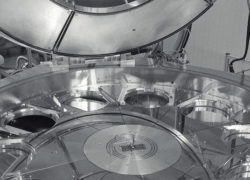Atomic Layer Deposition
Precisely controlled growth of monolayer stacks
The veins of an ALD reactor tool:
tailored gas lines.

FHR Anlagenbau GmbH is an innovative enterprise in the branch of vacuum processing and thin-film technologies. The company was founded in 1991 in Dresden, Germany by a group of engineers with a strong personal background of equipment design and technologies with the aim to develop and sell new
concepts and solutions for multiple applications of thin films in the industry and R&D.
FHR supplies thin-film technologies and equips customers around the world with tailor-made equipment for a wide range of applications.
The FHR technology portfolio includes:
- Advanced metallization technologies by magnetron sputtering and CVD
- Reactive sputtering technologies for deposition of oxides and nitrides
- Advanced etching technologies by support of high density plasma sources Flash Lamp Annealing (FLA) for treatment and modification of semi- conductors, metals, ceramics, nanostructures and photonic materials
- Atomic Layer Deposition (ALD) for precisely controlled growth of mono-layer stacks joined with excellent uniformity of thickness on complex 3D shapes
Besides cluster type and roll-to-roll type equipment for thin-film processing on small dimensioned and flexible substrates, FHR provides in-line type systems for the large area coating and supplies high-quality, bonded sputtering targets. Since 2008 FHR-Anlagenbau GmbH belongs to the centrotherm photovoltaics AG, a leading international provider of technology and services for the production of solar cells and solar silicon.
Deposition of ultra-thin films joined with excellent uniformity of thickness requires a special deposition technique. Atomic Layer Deposition (ALD) makes a suited technique available, based on sequential saturating surface reactions, which make it a unique coating method among Chemical Vapour Deposition techniques. The Atomic Layer Deposition is carried out by alternating substrate exposure of at least two chemical reactants (precursors). First one precursor is flushed over the substrate. Precursor reacts with reactive surface sites (chemisorption) until there are no more unreacted surface sites (saturation). Then the gaseous reaction residuals of first precursor are purged with inert gas.
The second precursor is then flushed and again surface reaction take place until saturation has been reached. After purging the reaction residuals of second precursor, the cycle can be started again by flushing the first precursor. Complementary and self- limiting surface reactions in the ALD process provides uniform films of controlled thicknesses down to the nanometer scale as well as conformal films with excellent step coverage onto complex 3D surface shapes. For the ALD processing FHR An- lagenbau GmbH offers custom-made reactor tools, designed for R&D activities and series production in industrial scale.
Advantages of ALD processing
- Deposition of ultra-thin films from 50 nm down to 1 nm
- Low processing temperatures: 150°C … 400°C
- Very controlled growth of monolayer sequences
- Excellent homogeneity and uniformity of thickness on complex 3D shapes
- A wide range of precursors available
Typically deposited thin-film materials
- Oxides: HfO₂, Al₂O₃, La₂O₃, SiO₂ …
- Nitrides: TiN, TaN, SiNx…
- Metals: W, Ta, Cu, Ru
Atomic Layer Deposition Example cycle for Al₂O₃ deposition
ALD 300
R&D solution with option for in situ analyzing

Wafer diameter
- 150, 200, 300 mm
Loading
- Manual, one substrate, cleanroominput station
Number of handling chambers
- One
Handling chamber
- Aluminum, heated up to 80°C, four ports
Number of load locks
- One
Load lock
- Nitrogen cooling, with one pocket
Number of process chambers
- Two
Process chamber 1
- Aluminum, heated up to 200°C,
- argon rinsed windows
- Gas shower head, two gas channels
- Central gas inlet port
- Substrate heating up to 600°C
- Ellipsometry measurement port
Process chamber 2
- Aluminum, heated up to 150°C
- Titan, heated up to 200°C (inherent chamber)
- Gas cross-flow, two gas channels
- Lamp heater: 100 mm diameter, up to 1000°C
- Substrate heating up to 500°C
Gas system:
Process chamber 1
- 4 precursor gas lines (heated up to 200°C/230°C)
- 4 bubblers (1 x cooled, 3 x heated)
- 7 gas lines, 2 gas line reserves
Process chamber 2
- 4 precursor gas lines (heated up to 200°C/230°C), 2 reserve ports
- 4 bubblers (2 x cooled, 2 x heated)
- 2 gas lines, 2 gas line reserves
ALD 300
Industrial solution with wafer fab interface
ALD 300
Industrial solution with wafer fab interface

Wafer diameter
- 300 mm
Loading
- Fab interface with two ports for standard wafer stacks (25 pcs.)
Number of handling chambers
- One
Handling chamber
- Aluminum, heated up to 80°C, four ports
Number of load locks
- One
Load lock
- Nitrogen cooling, with two pockets
Number of process chambers
- Two
Process chamber 1
- Aluminum, heated up to 200°C, argon rinsed windows
- Gas shower head, two gas channels
- Gas cross-flow, two gas channels
- Substrate heating up to 600°C (cross-flow: up to 400°C)
Process chamber 2
- Aluminum, heated up to 200°C
- Gas shower head, two gas channels
- Gas cross-flow, two gas channels
- Remote plasma system
- Substrate heating up to 600°C (cross-flow: up to 400°C)
Gas system:
Process chamber 1
- 4 precursor gas lines (heated up to 200°C/230°C), 1 reserve port
- 4 bubblers (1 x cooled, 3 x heated)
- 5 gas lines, 4 gas line reserves
- Liquid flushing
Process chamber 2
-
5 precursor gas lines (heated up to 200°C/230°C)
-
5 bubblers (1 x cooled, 4 x heated)
-
7 gas lines, 4 gas line reserves





